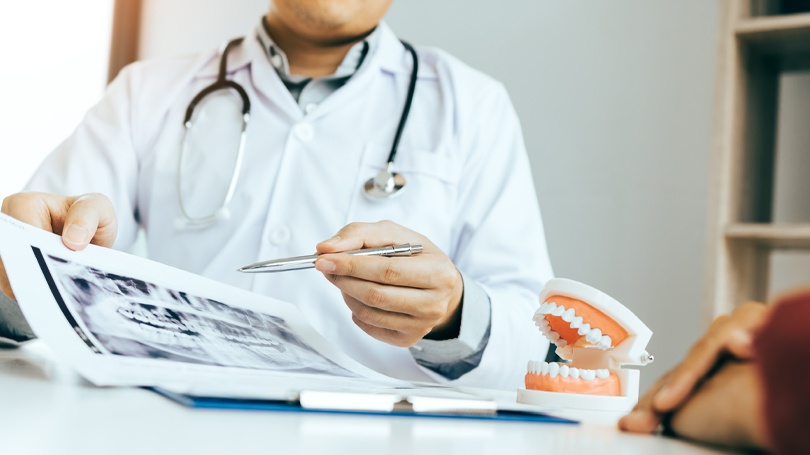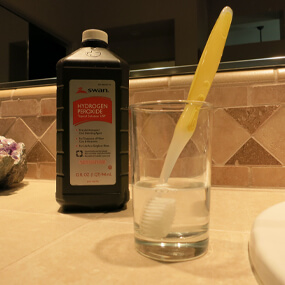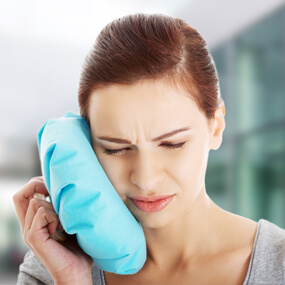Sleep Apnea: Dentists as the First Line of Defense

Obstructive sleep apnea has garnered much greater attention in recent years as it has become associated with many diseases and even death. Nearly 6 million Americans are diagnosed, and estimates put the number of undiagnosed at nearly 24 million. That disparity may be due to inadequate training throughout the health care industry. The responsibility largely falls on dental professionals. Dentists must be trained in sleep apnea diagnosis and treatment. They must implement screening protocols, and they must embrace an interprofessional approach to caring for a patient. This will result in improved health as patients are diagnosed earlier and treated in an effective and efficient manner.
There are different types of sleep apnea. Obstructive is the most common variety. A person with obstructive sleep apnea will experience a completely or partially closed airway at intermittent periods throughout sleep. Apnea occurs when a person temporarily stops breathing, and hypopnea occurs when a person experiences reduced oxygen intake. In either case, this is a potentially life-threatening condition that causes increased levels of carbon dioxide in the blood as well as other medical conditions.
Considering that the average American visits his or her dentist at least twice a year, dentists play a pivotal role in the early detection of apnea and hypopnea. A dentist can recognize the risk factors based on extraoral exams and intraoral exams but also the medical history of the patient. A dental professional can establish an initial diagnosis. The patient is then referred to a doctor who specializes in sleep apnea and can perform the conclusive analysis as well as assess treatment options if applicable.
Obstructive sleep apnea increases rates of illness and death. This accentuates not just the importance of early detection but the need for various medical professionals to work together. An interprofessional approach can also improve health conditions that often coincide with sleep apnea.
By studying sleep apnea and hypopnea, the American Academy of Sleep Medicine has developed criteria upon which dentists and other medical professionals can base their diagnoses. A definitive diagnosis is generally achieved via a polysomnography at a facility where the patient can be monitored during sleep. The data collected includes the number of episodes per hour, and that rate generally determines whether the obstructive sleep apnea is categorized as mild, moderate, or severe.
Obstructive sleep apnea is often associated with comorbidities, which are conditions that often occur simultaneously but independently. The comorbidities linked to sleep apnea include gum disease, diabetes, high blood pressure, and cardiovascular disease. People with sleep apnea have higher rates of disabilities and death than others. While sleep apnea is linked to diabetes, it is also linked to diminished glucose tolerance and resistance to insulin. In fact, the association is so strong that the American Diabetes Association recommends regular sleep apnea screening in order to detect diabetes.
This condition is also a major contributor to high blood pressure but also negative pressure swings and other events that damage blood vessels. Sleep apnea and hypertension that go untreated put a person at greater risk of strokes and heart attacks. In more than 60 percent of strokes, heart attacks, and related events, sleep apnea has been diagnosed after the fact. As with the American Diabetes Association, the American Heart Association also recommends regular sleep apnea screening due to the association.
People with sleep apnea often have irregular heart rhythms as well. These unusual cardiac rhythms have been linked to death while sleeping. Brain functions can be disrupted too. Reduced quality of life from sleep apnea often occurs due to attention deficits, memory issues, inabilities to think clearly, and even reduced hand-to-eye coordination and diminished motor skills and dexterity.
As for the correlation between sleep apnea and periodontitis, it can be attributed to the increased inflammation that each condition causes. The specific causes of inflammation due to sleep apnea are not yet known, but research does link it to gum disease and other issues of the oral cavity.
Risk Factors
Both age and gender are risk factors. In fact, the likeliness of sleep apnea increases with age up to about 60 years old. Hormones, as well as pregnancy, can be risk factors. Lifestyle is certainly a risk factor, and obesity, in particular, is found at a high rate among people with sleep apnea. Obese people often experience a buildup of tissue in the neck and head that contributes to obstruction of their airways.
As for gender, sleep apnea is more prevalent among males, and this has much to do with both anatomy and physiology. In fact, males and females tend to experience variations in their symptoms. Women are more likely to experience weariness, whereas men are more likely to experience snoring. Men are not only more prone to heavy snoring but more prone to apnea as opposed to hypopnea. Hormonal changes are prevalent among people with sleep apnea. Postmenopausal women, for instance, are more likely to experience sleep apnea than premenopausal women. Pregnant women are at the greatest risk in the third trimester because this is when the weight gain is greatest. If sleep apnea occurs during pregnancy, it can actually cause low birth weight and other negative outcomes for both the child and the mother.
Symptoms
The symptoms of sleep apnea can actually manifest while a person is awake. Smoking can cause inflammation in the pharynx that restricts the airway. Alcohol or any sedative can limit muscle activity, which can exacerbate sleep apnea symptoms. Apnea can be so disruptive that a person will often feel unrested despite an adequate length of sleep. Individuals who only experience symptoms at night are often unaware. It is often a partner that makes a person aware of the episodes. These symptoms can include gasping, choking, restlessness, bad dreams, acid reflux, drooling, and even excessive perspiration.
People with sleep apnea will often feel excessively tired throughout the day. Restlessness and insomnia from sleep apnea can also lead to headaches in the morning, irritability, and even depression. Challenges focusing, as well as other cognitive problems, can also occur. Note that such symptoms do not confirm a diagnosis. There are other reasons that such symptoms can occur, so a definitive diagnosis is needed.
Clinical Features
Features of the neck and head, both in the oral cavity and externally, can indicate sleep apnea. Such features are often easily recognizable during a screening. These characteristics can include a large neck circumference, increased face height, a receded jaw, an unusual jaw angle, and so forth.
It is not unusual for an affected person to have a wide tongue near the tonsils along with a vaulted roof mouth, which is a combination that can block the airway. A hard palate can reduce airflow through the nose. There are also numerous features within the oral cavity that can cause airway restriction should they be enlarged. Acid reflux can cause erosion. Bruxism is often linked to sleep apnea because many patients will grind their teeth and clench their jaws in the wake of an episode. Tooth loss can actually change the shape of the face, head, and neck and therefore create an airway obstruction.
Screening Tools
Although polysomnography is ideal for diagnosis, it is often not practical for early detection. Dentists and other medical professionals must, therefore, use other methods to identify risk. Modern screening methods are easy to adopt and effective, and they deliver fast results. One method is the Berlin exam, which covers sleepiness, daytime fatigue, and snoring within the context of head and neck measurements and the medical history of the patient. Another method is the STOP-BANG or SBQ exam. This method subjectively evaluates weariness, snoring, blood pressure, and known apnea episodes, and that data is considered within the context of age, gender, BMI, and neck circumference. There is also a more streamlined approach to this method that reduces it to just four yes-no questions.
A methodology known as the Sleep Apnea Clinical Score measures likeliness based on factors like known apnea episodes, high blood pressure levels, snoring, and neck circumference. The Epworth Sleepiness Scale (ESS) deals with one of the most common symptoms of the condition. User responses to the ESS questions range from zero to three, and a final score above 10 indicates a high risk. The NoSAS score is a simple method that assesses age, gender, BMI, neck circumference, and snoring. The Obstructive Airway Adult Test or OAAT features questions with multiple choices. These questions deal with known episodes, risk factors, symptoms, and comorbidities. A final OAAT score identifies a person as at a mild, moderate, or severe risk for sleep apnea. However, the OAAT approach is relatively new and still requires additional study and perhaps refinement before it becomes as prevalent as the other means available.
Treatment Options
The severity and even the symptoms of obstructive sleep apnea differ from person to person. Therapy is personalized to the individual, and a variety of treatment options along with recommendations for lifestyle changes are presented to the patient. A continuous positive airway pressure or CPAP facemask is the benchmark by which all other treatments are measured. However, CPAP therapy is generally reserved for the most severe cases. When a case does demand CPAP, it can have a tremendous effect on the patient, including normalizing blood pressure, improving cognitive function, and alleviating daytime weariness. The biggest obstacle is often the patient not wearing the facemask regularly.
Dentists cannot perform a final diagnosis of sleep apnea, but a dentist can be a sleep medicine specialist and even fabricate the mouthguards that may be used in lieu of a CPAP machine. In fact, oral appliances are used in most mild and moderate sleep apnea cases. Mouthguards are even used in severe cases when the patient will not or cannot use a CPAP facemask. The most commonly used mouthguard is designed to keep the lower jaw in its proper position and avoid collapsing of the palate and pharynx. There can also be an element that is designed to keep the tongue in place to ensure an open airway.
Surgery is also an option for many patients affected by sleep apnea, and common surgeries include reconstruction of the airway as well as an airway bypass. The goal of these surgeries is either to eliminate the obstruction or work around it when elimination is not possible. This solution is only viable for those dealing with an anatomic obstruction, and since there remains a dearth of data regarding such surgeries, surgery remains a controversial option among medical professionals.
There are also physical therapies available that target aspects of the mouth and neck. Such therapies are generally not prescribed as a sole treatment but rather used in conjunction with other methods. The apnea-hypopnea index or AHI measures the severity of the condition, and research has demonstrated that the aforementioned therapies reduce AHI levels by 50 percent in adults and 62 percent in children. These therapies also reduce snoring, improve oxygen saturation, and mitigate other symptoms.
An emphasis on lifestyle changes is all about managing risk. Eating well and exercising regularly is the ideal way to control weight. Quitting smoking and reducing alcohol consumption can reduce the severity of symptoms. If a person is experiencing sleep apnea in whole or part due to how they sleep, positional therapy is often prescribed in order to foster healthy sleeping habits.
Schedule Your Sleep Apnea Screening
We all need quality sleep. If you are experiencing poor quality, it can diminish your appearance, energy levels, and overall health. It can even disrupt your relationships and ability to enjoy life. Jeffrey D. Clark, DDS, and the entire team at Scottsdale Cosmetic Dentistry Excellence are committed to early diagnosis of sleep apnea and bruxism. Dr. Clark is a leader in oral disease detection and prevention and has established a comprehensive screening protocol that can protect you and your entire family. A custom nighttime mouthguard is often the simplest, most effective, and most affordable way to keep your airway open and avoid teeth grinding while you sleep. A mouthguard will protect your teeth but also result in better sleep, which means greater energy, better health, and more happiness. Are you ready to get screened? Contact Scottsdale Cosmetic Dentistry Excellence at 480 585 1853 and schedule your consultation today.
Reference: Casa-Levine, RDH, EdD, Cristina. “Dental Screening for Obstructive Sleep Apnea.” Vol. 4, no. 11, Decisions in Dentistry, Nov. 2018, pp. 38–41., decisionsindentistry.com/article/dental-screening-for-obstructive-sleep-apnea/.




